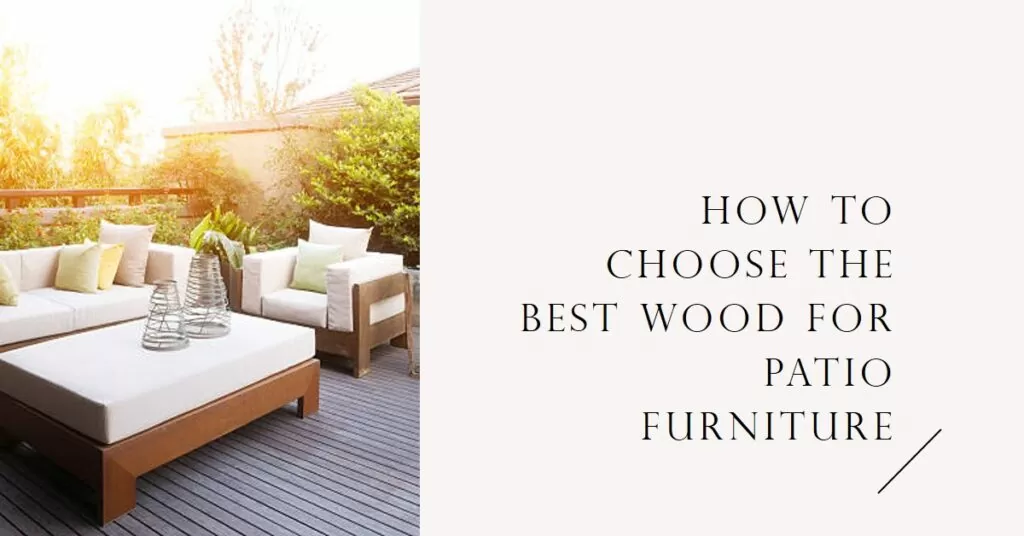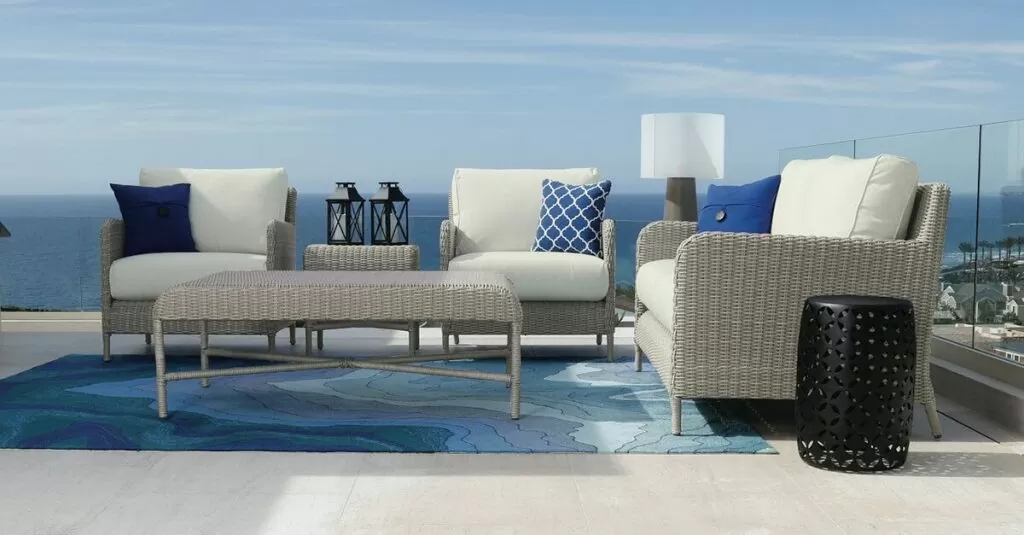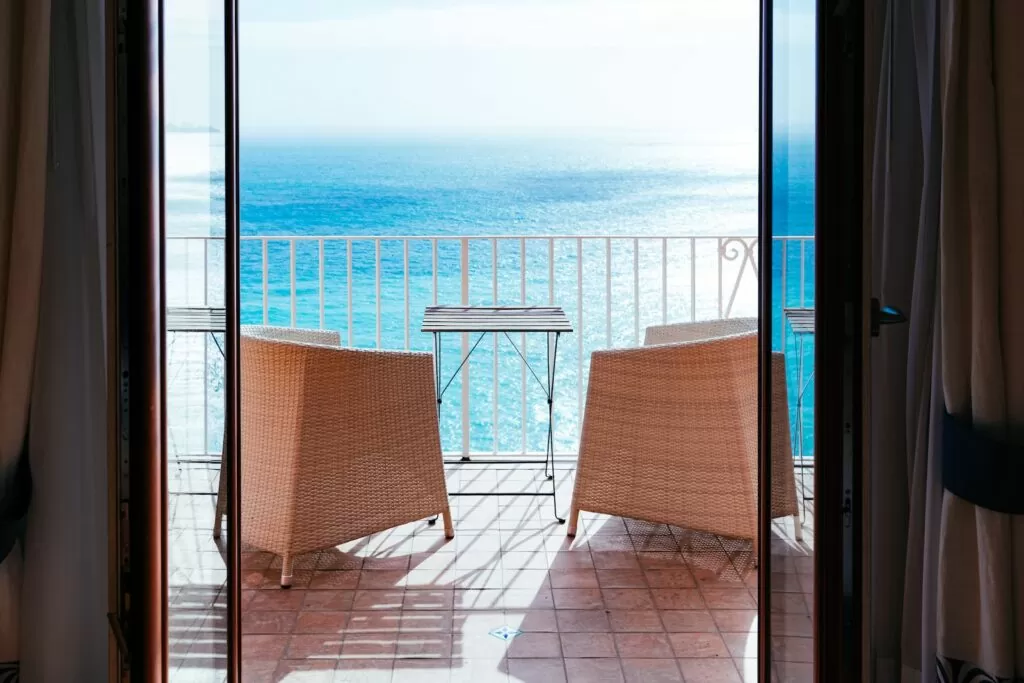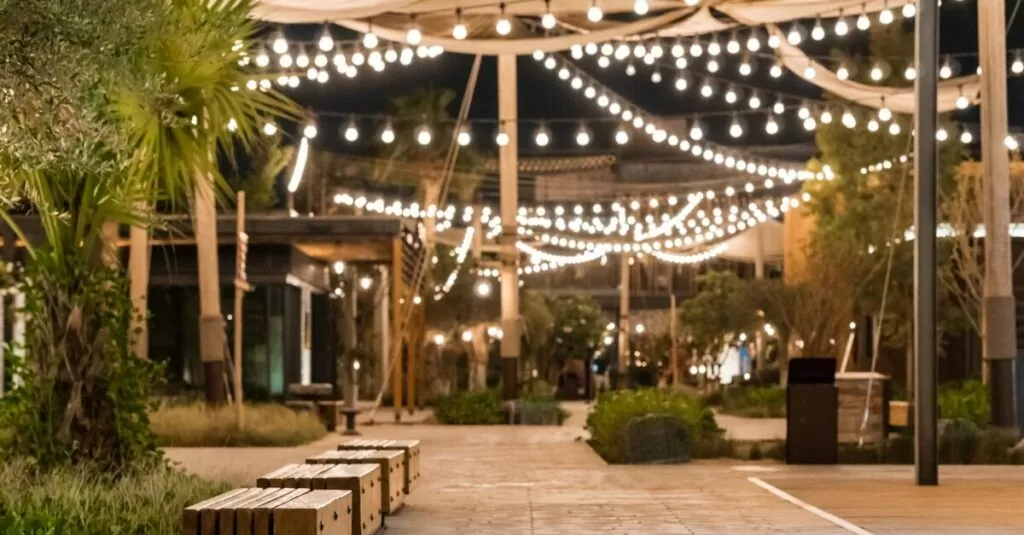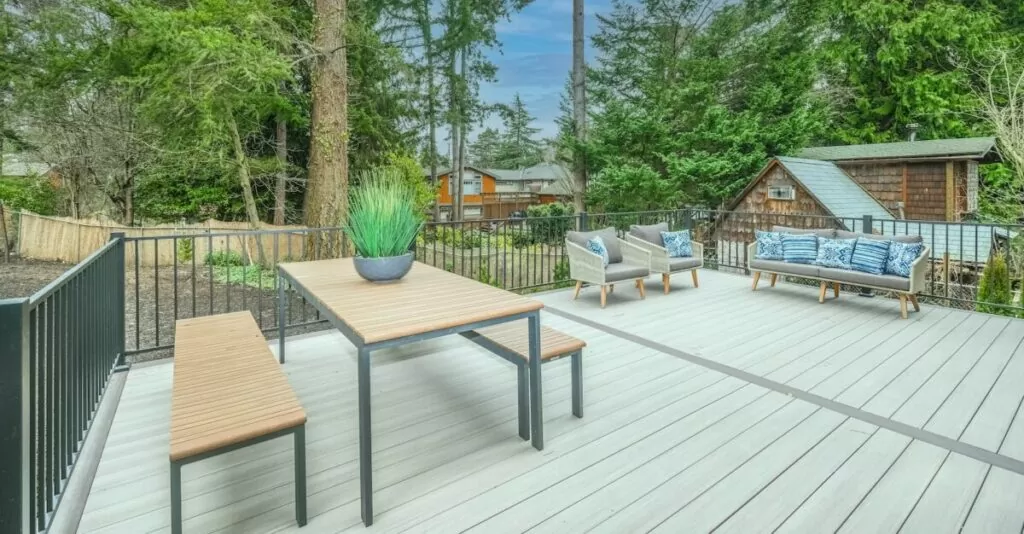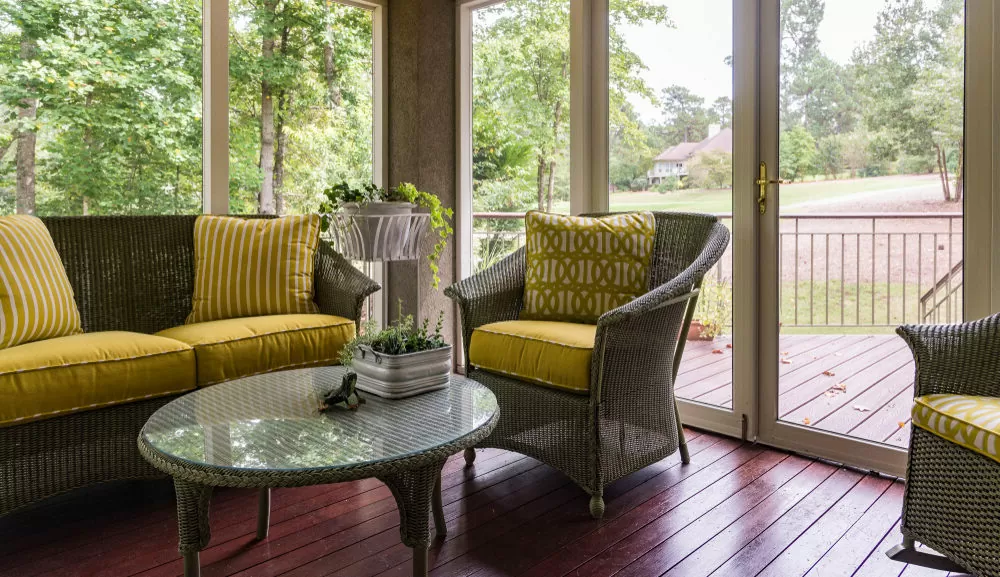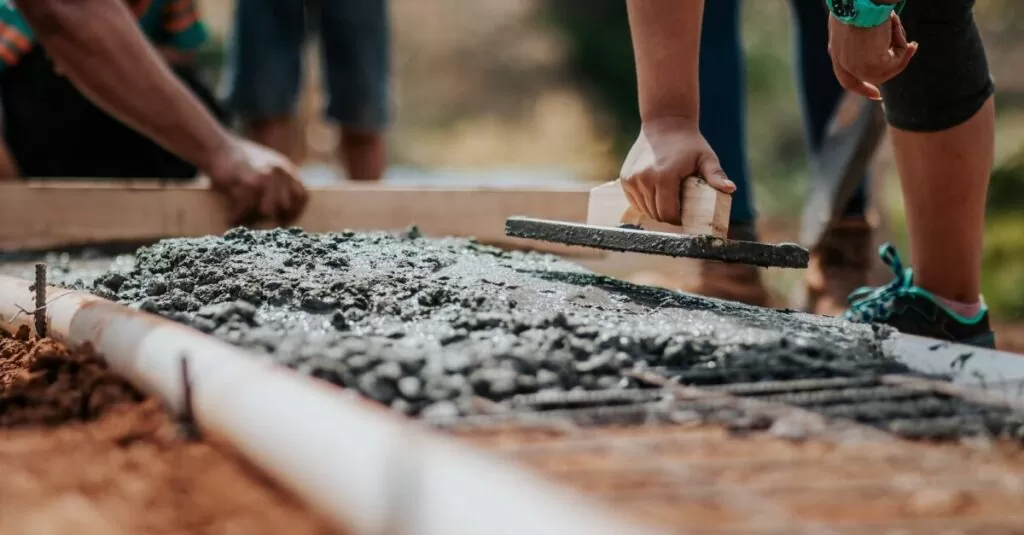Understanding Different Types of Wood for Outdoor Furniture
Wood is having a moment. It’s one of the more popular outdoor furniture materials today, prized for its natural look and cozy textures. But “wood” is a broad topic, and there are lots of different types of woods out there when you go shopping for a new dining set or patio sofa. So, how do you know the difference? How do you make the smartest choice for your home, environment, and personal style? Let’s break it down!
When it comes to selecting the best material for patio furniture, understanding the types of wood available to you is essential. As far as natural woods go, teak is widely recognized as optimal for outdoor furniture due to its water and weather resistance, along with its stability when exposed to humidity and temperature changes. Cedar, on the other hand, offers a more affordable price point along with its minimal warping tendencies. Redwood is also a popular outdoor furniture material due to its ability to age well and resist rot, insects, and decay. Other choices include Ipe, Acacia, and Eucalyptus. And making things even more complicated, the last decade has seen the meteoric rise of synthetic “wood composite” materials – a type of poly lumber, exemplified by brands like Trex and Polywood, that is a fusion of polymer resin and real natural wood fibers.
The debate between natural and synthetic materials can be contentious depending on who you ask. Natural woods offer a look that is aesthetically pleasing while also being environmentally conscious in that the production process emits fewer toxins and negative pollutants into the atmosphere compared to synthetic options. Additionally, natural woods can sometimes be easier to work with if you plan on refinishing or maintaining your furniture throughout its life-span. On the flip side, synthetic materials offer increased protection against water damage and require less maintenance than traditional wooden furniture which may appeal to those with busy lifestyles. Ultimately, what type of material you choose comes down to personal preference and budget constraints when deciding on which type works best for your needs.
No matter what material is chosen for your patio furniture, knowing the basics of each option can help simplify the decision process and ensure that your purchase stands up to whatever Mother Nature decides to throw at it over years of use. With a better understanding of both natural and synthetic wood options for patio furniture, you can now begin exploring ways to choose between them in order reach a final decision on which product will suit your needs best.
Natural vs. Synthetic Wood Materials
When it comes to outdoor furniture, natural wood materials and synthetic materials have vastly different characteristics and advantages. Natural wood is a go-to option for many homeowners due to its ease of use and traditional aesthetics. Synthetic materials can offer increased durability, lighter weight, and lower price than natural material solutions. Both materials have pros and cons, so here are some considerations when making the decision between natural versus synthetic.
Advantages of Natural Wood:
Natural wood furniture is attractive and stylish, yet often comes with a higher price tag due to its natural properties increasing both its durability and realistic look. Those who want a look that will last longer may choose untreated hardwood because of its toughness against the elements. Additionally, natural woods can be modified or colored in many ways unlike synthetic materials which cannot be treated in the same fashion.
Advantages of Synthetic Materials:
This type of material (poly lumber) is highly resistant to weather conditions such as rain, hail, sunlight, etc., making them ideal for those who want more budget options that still look good after years of exposure to the elements. They are also lighter in weight compared to their natural counterparts which makes them easier for transport and rearranging on patios/decks. Furthermore, faux-wood items require less maintenance since they do not need to be sealed or painted as often as real wood products.
No matter your preference or budget requirements, there is an appropriate patio furniture option available for all tastes from either a natural or synthetic material source. Whichever material or style you pick will come down to personal preference, available budget, length of ownership time desired and the climate where you live – all factors worth considering when selecting outdoor furniture for your home.
Weather and Temperature Considerations

Once you’ve decided on the materials you would like to use, it’s important to consider the weather conditions that your outdoor furniture will be exposed to. Natural woods are sensitive to both heat and cold temperatures, meaning they can become warped or cracked due to sudden changes in humidity. Some natural woods, of course, are more susceptible to this than others. A tropical wood or a wood that tends to grow in humid climates is more readily able to handle atmospheric moisture. But if you take a wood that is great for humid environments, where it is allowed to expand and contract naturally, and then stick it into an excessively dry and arid environment, you may start to have cracking problems and need more maintenance to keep it going. On the other hand, things like redwood and oak simply don’t do as well in humid environments, as they are better suited for drier climates.
Synthetic woods are designed to resist temperature fluctuations and are much better suited for outdoor use in all climates. Some synthetic wood products even come with guarantees against discoloring, warping, and cracking due to UV light exposure and high humidity.
Another advantage of synthetic wood is its resistance to mold and mildew growth. Moisture builds up outdoors and the porous surface of some natural woods absorbs this moisture which can cause mold spores to grow. If left unchecked, this could lead to health risks from breathing in mold spores. By contrast, synthetic wood is impervious to these conditions and won’t absorb or retain moisture, making it an ideal material for patio furniture when considering weather and temperature.
So synthetic woods are pretty great, right? Well, not so fast. For one thing, natural wood has that authentic natural wood look that is so desirable. Two, the highest quality woods (with proper maintenance) are quite similar to poly lumber in terms of their durability and versatility. And three, depending on the wood you’re comparing to, composite resin materials can often be more expensive.
No matter which material you choose, selecting patio furniture made out of quality materials resilient enough to withstand the elements is essential. Whether you opt for natural or synthetic wood, make sure it’s treated properly so that any harshness in the climate won’t permanently damage your investment over time. With a clearer understanding of the material type best suited for your environment, let’s move on and discuss some other features you should consider when choosing wood for patio furniture.
Things To Consider When Choosing Wood for Patio Furniture
Just to bury the lede a bit here, we only sell Ipe and Teak outdoor furniture, because in our nearly 20 years of experience, those are simply the materials that hold up best in the most North American environments. Other woods are strong in some places and weak in others, and some woods that some brands use in their patio furniture really shouldn’t be used in patio furniture at all (if you don’t want to swap your sets out every two seasons). Still, let’s run through a number of common woods you’ll find used for furniture, and discuss them briefly.
The type of wood you select for your patio furniture plays an important role in how it will look and last over time. With a plethora of options to choose from, there are certain factors to consider when deciding on the best wood for your outdoor furniture.
When choosing wood for patio furniture, take the weight into account. Lightweight woods such as cedar and teak are popular choices for small pieces since they make them easily moveable, while heavier woods like pine and oak are better suited for larger pieces that aren’t going to be moved often (though again, remember that pine and oak are not well-suited for outdoor use in places where rain, snow, or humidity are common). You should also consider the amount of decorative detail or embellishments you would like present in the piece– if intricate carvings or other such aesthetic embellishments are desired, then woods with a tighter grain such as mahogany and cherry are great options due to their fine texture. However, if a more rustic look is what your eye is drawn to, then more open-grained woods like fir and redwood may be better suited for your project.
These two different types of grains can also be useful when confronting changing temperatures due to weather exposure. Woods with tight grains tend to resist destructive forces from exposure better than those with open grains, so they may be the wiser option if extended sun exposure or heavy rain is expected in the area where your patio furniture will be located. On the other hand, if your furniture remains somewhat protected under a covered porch or roof structure, then open grained woods may suffice just fine despite their susceptibility to environmental changes.
And of course, durability is always a consideration when buying outdoor furniture as it needs to withstand temperature changes as well as wear and tear from constant use. Ultimately, understanding the features associated with each kind of wood will help make sure you get the most out of your new patio furniture investment. Knowing what kind of environment your items will be exposed to and researching which type of wood is most capable of handling its conditions can save you from replacing items prematurely.
About Durability
When choosing patio furniture, durability is of utmost importance. Warranty information and customer reviews can be helpful when evaluating the longevity of a piece of furniture. Wood that has been treated with protective coating and finished appropriately is likely to last longer. Natural decay-resisting woods such as teak, cedar, and redwood tend to offer better protection against the elements and require less maintenance, but they can also be more expensive. On the other hand, untreated soft woods such as pine, fir, or birch are typically cheaper, but have shorter life spans due to their susceptibility to rot, wear and tear from outdoor conditions.
Ultimately, whether you choose a treated wood or an untreated wood for your patio furniture should depend on budget and preferences; however, it’s important to consider the long-term cost of upkeep if opting for a less expensive option with shorter life span. No matter which option you select, maintaining your patio furniture regularly will extend its life span significantly.
So, What is The Best Wood For Patio Furniture? Ipe or Teak.
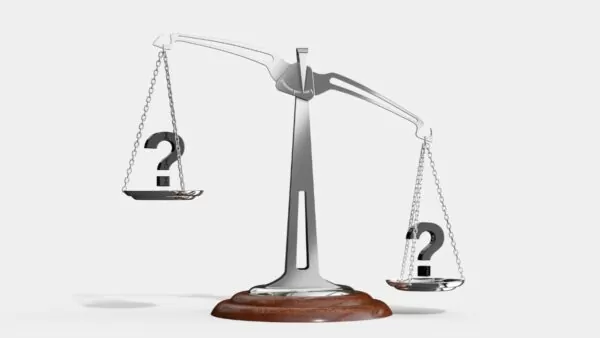
Ipe and Teak are two of the most popular all-natural wood materials used in the manufacture of patio furniture, in no small part due to their outstanding durability, beauty, and strictly-tested weather-resistance.
Ipe is an extremely dense wood that’s known for its longevity and resistance to decay. It has a beautiful grain pattern and can sometimes be found in a variety of colors that make it perfect for modern decor. In our store, we supply Ipe patio furniture only in a natural finish, but we offer over 150+ unique pillow and cushion fabric designs to customize the look of your piece.
Teak is also a notable choice (and our preferred wood). Teak is also extremely long-lasting and tough since its natural oils repel moisture – this makes it less prone to warping or cracking in extreme weather conditions. It has an elegant honey-brown hue that pairs well with pretty much any style of furniture – modern, mid-century, rustic, and tradtional designs all look fantastic in teak.
Both woods are notably pricier than other options, such as pine or cedar. Pine or cedar furniture are the kinds you generally find on the floor at your local big box store or supermarket. But, teak and ipe furniture requires less maintenance over time and these woods can easily last up to 50 years with proper care. However, when deciding between Ipe and Teak for outdoor furniture, there are some pros and cons on both sides to consider.
The debate between Ipe versus Teak comes down to personal preference—some might value Teak’s aesthetic advantages while others prefer the lower cost of Ipe. Ultimately, no matter which type of wood you choose for your patio furniture, it will be an investment worth making if cared for properly – they both are among the best materials for outdoor furniture in our book, and you won’t regret the purchase of either. With these high quality woods, you are truly buying it for life.
Pros and Cons of Teak and Ipe For Patio Furniture
Regarding outdoor furniture, two of the most popular woods used are teak and Ipe—both for their incredible strength and durability. Teak is known for its natural oils, making it resistant to rotting, warping and insects, while Ipe is a dense tropical hardwood from South America that’s highly durable, stain-resistant and chemical-resistant. Both materials make exceptional options for patio furniture.
The Pros of Teak Wood Furniture
- Teak is an extremely strong wood that can sustain all year round exposure to the elements.
- It is highly resistant to pests, rotting and warping and it won’t need to be treated with sealers or protective coatings to last outdoors.
- The fact that teak has been used as a patio furniture material for decades makes it easy to find high-quality pieces at affordable prices.
- The finish depends on your maintenance method: many homeowners prefer teakwood’s warm honey color, which can be maintained indefinitely with annual or semi-annual application of teak oil and sealer. On the other hand, if left untreated, teak naturally becomes a silvery gray color over time, which some people really like. This color shift does not affect the strength of the material, so you have options here depending on your time and interest!
The Cons of Teak Wood Furniture
- The biggest visual downside of teak furniture is that its color fades over time when exposed to sunlight and weathering; as such, many people opt to use sealants or protective coatings in order to maintain its original color. And yes, we’re double-dipping, as this “con” was also a “pro” above. Honestly, whether this is positive or negative depends on you!
- Teak typically commands higher prices than other wood outdoor furniture due not only to its durability but also its aesthetic appeal,
- If not well cared for, teak can become brittle and more likely to break over time, but this depends very much on your environment. I have a teak club chair that’s been sitting untreated in my Colorado backyard for six years and while it’s gone mostly gray, it’s still really strong, comfy, and good-looking.
The Pros of Ipe Wood Furniture
- Ipe decking has become increasingly popular for outdoor patios largely because its impressive qualities make it ideal for extended exposure to the elements–its density makes it exceptionally durable, rot-resistant, fire-resistant and weatherproof. And generally, an outdoor-grade material that is good for decking is also good for patio furniture.
- Ipe wood is denser than other woods like cedar or redwood, so it will also take on beautiful hues like deep brown or reddish brown when oiled or stained properly. This means you can add some color variation within your patio without worrying about fading due to long-term sun exposure.
The Cons of Ipe Wood Furniture
- The main downside of using Ipe as patio furniture material is that it costs significantly more than many types of wood furniture on the market today. Depending on the plantation where its grown and the manufacturer, Ipe can be more or less expensive than teak. Read about our picks for the best patio furniture brands to discover some sustainably sourced, high quality vendors of Teak and Ipe furniture.
- While there are several treatments available on the market specifically formulated for use on Ipe wood products in order to prolong the life of shared spaces like patios, these treatments can be fairly expensive and often require frequent maintenance to keep structures looking great (which may not fit all budgets).
- Ipe is heavier than teak, which is its main competition in the outdoor furniture space.
Both Teak and Ipe have their strengths and weaknesses but regardless both are excellent choices for your patio furniture needs. Having outline the benefits and drawbacks of these two common materials one can’t help but wonder: why is Ipe such a good wood for patio furniture?
Why is Ipe Such a Good Wood for Patio Furniture?
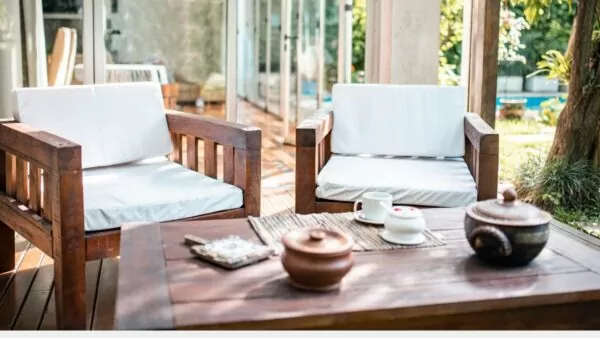
Ipe (also known as Brazilian Walnut) is widely considered the best (or second best) wood for outdoor furniture due to its long-lasting durability and low maintenance requirements. It is an extremely hard dense wood with natural oils, making it highly resistant to splinters, warping, and rot. Its resilience against insect damage and the elements make it ideal for patio settings. Additionally, Ipe’s rich brown colors & deep grains will often leave behind a beautiful patina of silver-gray over time that adds charm and sophistication to any outdoor space.
While Ipe does have considerable benefits for long lasting patio furniture, it is also one of the more expensive options available. Furthermore, many people find the color of Ipe too dark or intense for their needs so they may opt for more mild tone woods like teak or cedar instead.
However, considering the high level of durability that Ipe provides and the ease of maintenance it requires, it can be argued that Ipe is one of the best woods you can use to build your patio furniture out of.
Why is Teak Such a Good Wood for Patio Furniture?
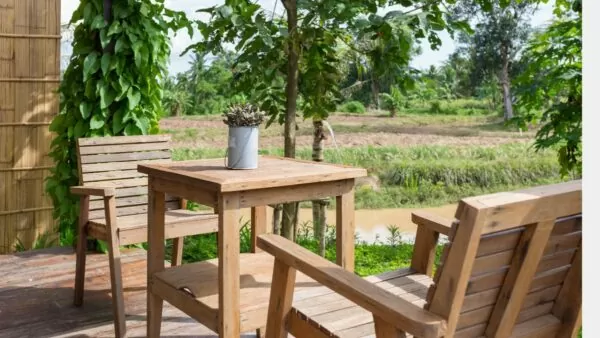
Teak is an incredibly popular and durable wood choice for patio furniture; it is widely considered the best (or second best) wood for outdoor furniture (see what we did there?). Teak typically has a high oil content which provides excellent water and rot resistance, making it naturally resistant to the problems that plague most outdoor lumber and thus ideal for outdoor furniture. Additionally, its tight grain and close cellular structure also makes teak highly resistant to cracking, splitting, and warping. Furthermore, the combination of these features makes teak furniture very easy to maintain as it does not require staining, resealing or repainting to retain its beauty for many years.
It may be argued that teak is too expensive for patio furniture. However, teak’s strength, durability, and low maintenance make it worth the investment as it will last up to five times longer than other woods like pine or cedar used in similar applications.
It’s hard for us to make a specific recommendation between teak and ipe for furniture; we’ve been selling teak furniture since 2009, and have had nothing but positive survey responses and personal experiences with teak furniture since. Ipe is a newer material for us, as we’ve only vetted it and cataloged it since 2016 – but so far, we are very impressed with it as a material, and have heard great long term outlooks from manufacturers who have used the material for decades.
Design and Look
Now that you’ve evaluated the durability of different types of wood materials for your patio furniture, it is now time to consider the look and design. Many people consider this factor the most important, so it’s important to evaluate all design aspects when selecting a wood for your outdoor furniture. Look for qualities such as beauty, durability, color, texture, grain pattern, and more. For example, teak is often a popular option because of its rich golden hue that radiates elegance and sophistication. Cedar also makes an attractive choice with its breathtaking mix of red and tan hues.
The overall look and feel of a material can add character to a space and enhance its aesthetics – something that shouldn’t be overlooked during the selection process. However, some folks may prioritize more practical aspects such as price and maintenance instead of strictly looking at appearance. Arguments exist on both sides of this issue- some prioritize style while others favor usability over vibrancy. Ultimately, each person needs to decide which one makes the most sense in their own unique situation. We know we’ve been throwing a lot of “it depends” at you, but furniture selection is a really personal thing; we primarily recommend teak and ipe, though acacia and cedar are also pretty good in most circumstances, and redwood is a situationally good pick as well; ultimately it all comes down to you.
Longevity
The design and look of your outdoor patio furniture is an important factor to consider when choosing which type of wood to use. But, it is also essential to factor in the longevity of the furniture. To ensure your outdoor furniture will stand up to wear and tear from weather exposure, you should choose woods that are strong and resilient. Timbers like Teak, Mahogany, Redwood, Cedar and White Oak are popular choices for outdoor furniture because they offer good resistance to the elements.
Choosing stronger woods can come at a cost. Some hardwoods such as teak are generally more expensive than softwoods like pine or cedar. In addition, some research suggests that sustainably sourced timber options may be more durable and longer lasting than non-sustainably sourced options. While there is less evidence to support this claim, it’s worth considering either option when assessing the longevity of your patio furniture.
Although the overall design and look of your patio furniture is paramount, keeping in mind its longevity and performance when faced with different types of wood can add years of life to your investment. For example, if you are looking for a piece that is going to be exposed outdoors for many years then investing in a heavier wood species may be worth it despite its higher upfront cost. Taking these factors into consideration should help you find a balance between design and quality, ensuring you get the best possible product for the job.
Once you have taken all these factors into account and chosen your ideal wood option, understanding the benefits of using wood for outdoor furniture becomes increasingly important.
Benefits of Using Wood for Outdoor Furniture
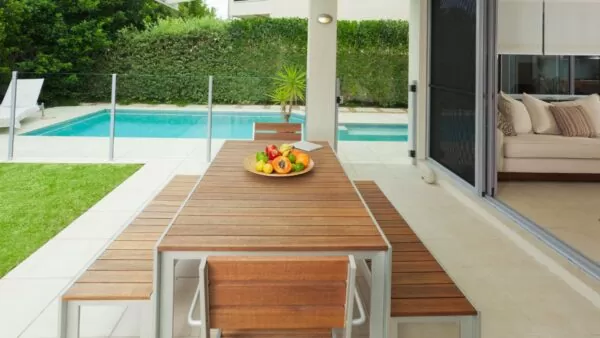
When selecting the best material for outdoor furniture, it is important to consider the benefits of using wood. Wood brings an organic, natural touch to a patio, and can be extremely durable when treated correctly. It is also relatively inexpensive and customizable, making it a great choice for beginner DIYers with a tight budget.
There are several advantages to using wood for outdoor furniture. First, it is sturdy and strong and can last for many years when properly treated with waterproof finishing and stored indoors before bad weather strikes. The wide range of available varieties also allows users to choose from many different styles depending on their preference. For instance, cedar, mahogany, and teak are all popular choices that offer resistance to rotting and warping. Additionally, wood provides an aesthetically pleasing look as it develops a patina over time that can add character to any outdoor space.
Some may argue that wood is not the appropriate choice for patio furniture because of its susceptibility to moisture damage. If left outside in rainy conditions or exposed to heat during summer months, wooden pieces can warping or even rot. There is also the need for regular upkeep such as cleaning and sealing to ensure the longevity of the furniture. And if left untreated for too long, mold and mildew may form on the surface.
Despite these potential drawbacks, wood remains one of the most versatile materials for outdoor furniture as it is easy to work with and customize for any design preferences. With adequate protection from the elements and proper maintenance using products made specifically for wood furniture – such as those by Thompsons WaterSea, Bear, etc… A – wooden pieces can withstand the elements better than many other materials available today. Combined these factors make wood an great material for any type of patio or backyard setting.

Todd is a co-owner of Patio Productions and has worked extensively in the furniture industry since 2002, when he started a company that designed and manufactured bathroom vanities. He now has a hand in all online business operations, including keeping tabs on industry trends and making sure Patio Productions remains an innovative leader in the outdoor furniture space. He lives just outside of Denver, Colorado with his wife, two boys, and two dogs. They live on a lake where they can make the most of the outdoor lifestyle. His favorite patio furniture sets are his Harmonia Living sectionals.

